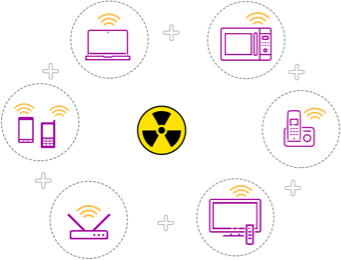Electromagnetic Hypersensitivity Syndrome (EHS) Electromagnetic Hypersensitivity Syndrome (EHS), a syndrome where people experience negative health effects from Electromagnetic Fields (EMFs) […]
Wireless has changed
LiveSAFE makes your
Your Wireless Gadgets and Radiation
Mobile phones, over the years, have changed the way the world functions. The usage of cell phones now rules every aspect of our life. Communication, information, shopping, travel, entertainment are now easily accessible and available at our fingertips.
Mobile phone technology has definitely improved our lifestyle but it has exposed us to high levels of microwave radiation everywhere all the time. Microwave radiation or electromagnetic radiation refers to radiation in the frequency range of 300 MHz to 300 GHz.
Long term exposure to electromagnetic radiation is proven to be hazardous for humans.
Are mobile phones the only source of microwave radiation? No, there are several others. Our lives are guided by several devices including TVs, inverters, microwave ovens, power distribution equipment, electric shavers to a wide range of wireless WiFi-enabled gadgets. According to a study by the Biological Institute of Germany, most Indian homes stand at a higher risk of electromagnetic radiation. This is further compounded by the advent of the IoT revolution that focuses on 24*7 connectivity.
Symptoms like headaches, sleep disturbances, chronic fatigue, to ailments like cardiovascular problems, fertility problems can be attributed to exposure to high levels of microwave radiation. Pregnant women and children are at especially higher risk.
At LiveSAFE™, we are committed to minimise your exposure to destructive electromagnetic radiation and help you lead a healthy and happy life.


What LiveSAFE™ offers
LiveSAFE™ offers you a series of products that may be used in your homes to help protect you and your loved ones from electromagnetic radiation (EMR). Choose the LiveSAFE™ way of life … your family deserves nothing less. LiveSAFE™ helps secure your home in three steps:
Audit the Level of CTR: During the audit, our experts will consider the layout of your space, the readings will be taken at all strategic locations where wireless devices are used and people work for the longest periods. Our experts consider exposure from internal and external sources during the audit. Most importantly, we focus on the layout, utilization of devices, and exposure of EMR. A detailed audit report is shared with the client and it is presented in two parts – an overview of the radiation sources and suggestive measures to reduce it. Our detailed audit report offers you tips on how to reduce your exposure to EMR – a carcinogen that is slowly gnawing our lives.
Install Safety Products: LiveSAFE™ recommends installation of its products only if the radiation levels are found to exceed recommended levels. Trained LiveSAFE™ technicians will install appropriate solutions from our range of proprietary products to reduce the levels of radiation, in a professional and responsible manner, with no change in aesthetics or impact on connectivity.
Re-evaluate Radiation Levels: Another EMR audit is conducted post-installation to analyze their impact. It is conducted using the same meter, at the same location and you can see up to 80-100% reduction in radiation. LiveSAFE™ products safeguard your home and family from excessive radiation without affecting connectivity or the quality of cell reception.
LiveSAFE™ Service Flow

EMR AUDIT
An expert-led assessment of your space to identify the source and evaluate areas of high and low EMR Exposure.
RECOMMEND
A detailed report comprising electromagnetic radiation readings and analysis is offered for your consideration along with effective solutions.
INSTALL
The recommended installations are made by trained LiveSAFE™ technicians, without affecting aesthetics or connectivity.
PROTECT
An EMR evaluation is done by the experts to check the radiation levels post-installation.
Clientele








Blogs
How can we help you?
LiveSAFE
447/A, 9th Cross,
2nd Phase, JP Nagar,
Bangalore 560078, India
- +91 9916 911 911
- contact@livesafe.in





